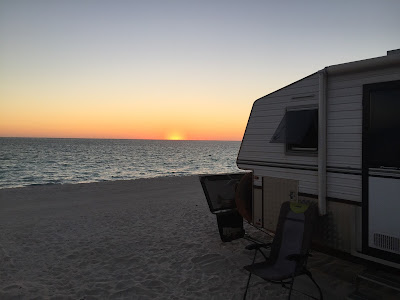Our first stop was Coral Bay, where we considered staying if we could find a suitable site at one of the two caravan parks. However, once we saw how crowded the vans were, we soon changed our minds. It was just way too busy for us.
We drove 15 km south of Coral Bay, then left the highway and turned towards the coast. We had heard that the corrugations and rocky outcrops on the 13 km access road were bad, so we stopped briefly to reduce our tyre pressures to better handle what lay ahead.
We were heading to camp at Warroora Station, which is pronounced Warra. The station runs along a 50 km frontage of the Ningaloo Reef.
Our campsite at the 14-mile was right on the beach, with a large sand dune behind us and the most fantastic view of the waves breaking on the reef in front.
Just before arriving at the caretakers' van, I saw a sign requesting that tyre pressures be dropped between 20 and 25 psi to handle the beach access, so I lowered ours to 24 psi. It was just as well because each site consisted of very soft sand. There is a dump point and a rubbish tip, as well as phone and internet coverage, on a hill above the rubbish tip. During our stay, I discovered a water pump located behind the dunes.
Our lagoon behind the reef was a fantastic spot to swim, where we saw turtles, and on our last day, a reef shark cruised by just a metre away in the water.
We regularly watched whales breaching outside the reef, and Craig, our next-door neighbour, caught squid from his boat, which were absolutely delicious when cooked with panko breadcrumbs.
It's a very popular spot, with 26 vans camped along our section of the beach north of the caretaker's caravan, and even more camping to the south and on a headland. The sites are spacious, and you don't feel hemmed in like you would in a caravan park.
On one of our Saturday mornings, we ventured into Coral Bay to shop and have lunch at Bill's Tavern.



























































